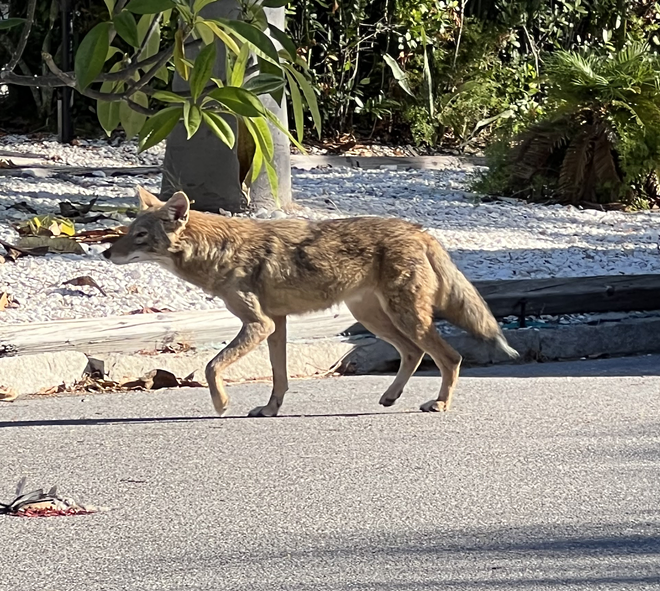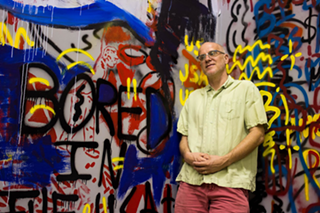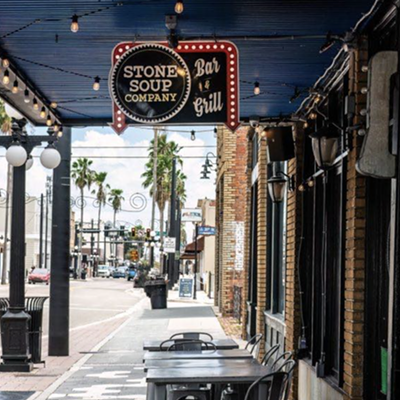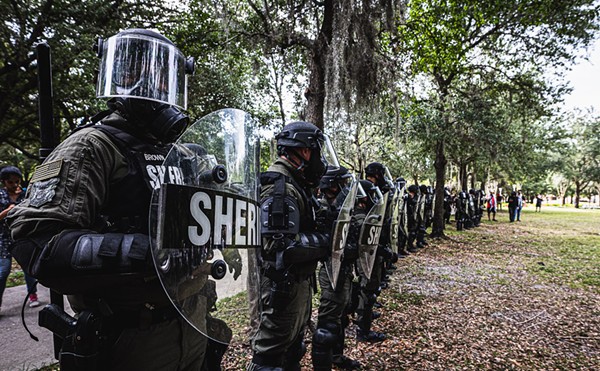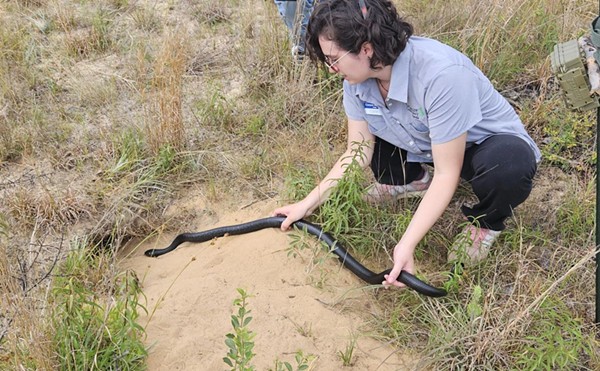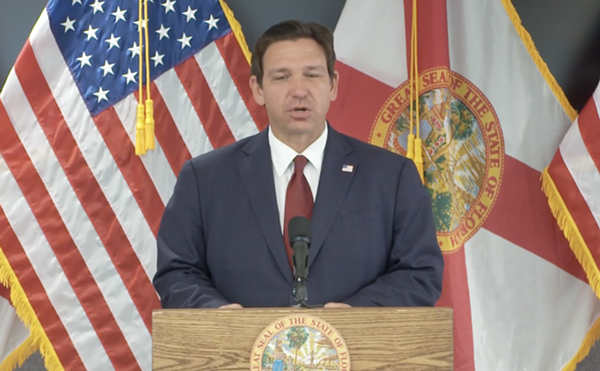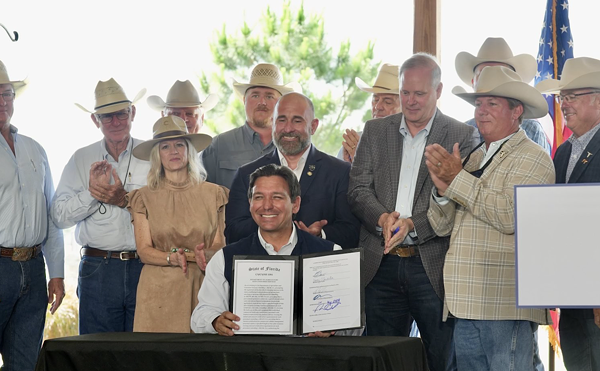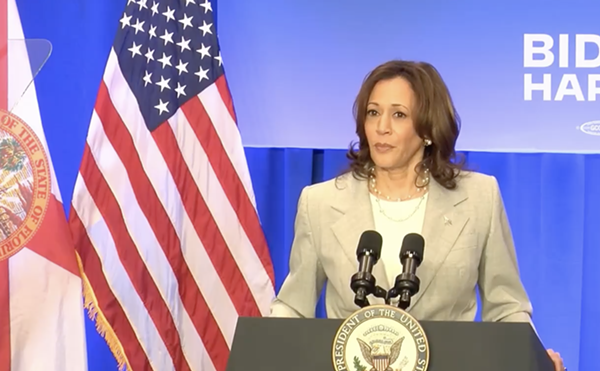The St. Pete Coyote can teach us how to get through uncertain times
City Wilds.
By Thomas Hallock on Mon, Nov 20, 2023 at 10:24 am
Coyote's been wandering my corner of south St. Pete. Folks leave out cat food for the strays. Coyote gobbles down the Meow Mix. And who knows? Maybe the Meows. Pets, they say, have vanished.
Few subjects polarize conversation on the neighborhood Facebook page more than this lonely canid, prowling in open daylight, minutes from downtown. He's almost always described as "He." The neighbors post pictures: "Currently on 17th Ave. and 1st." Dun and a little mangy, sharp ears pointed outward, piercing black gaze, tail tucked between his bandy legs. "He's quite beautiful," a Facebook regular says; "Just wish he was in a state park not ours."
In one video, the coyote trots down the hex block sidewalk right in front of my house. In another image, he stands on the easement, between the granite curb and a Home Depot palm. On the other side of the stockade fence is an aviary. Neighbors speculate over where he might live. (Driftwood? In the boatyards by the creek?) The Facebook discussion ranges between tolerance ("leave him be"), gun threats, misinformed paranoia, and concern for the children.
With online debates, few opinions ever change.
Truth is, Coyote is here to stay. Like most Floridians, coyotes came from somewhere else, having vastly expanded their range from the far West. They now inhabit every county in the state, and live in every U.S. state except Hawaii. They are, Fish and Wildlife reminds us, a very minor threat to humans. We might even consider them suburbanites. FWC tracks sightings on a cool interactive map. You'll find them from Miami to Jacksonville, around Orlando, down the Gulf Coast to Naples. And especially Pinellas County. Coyotes are not necessarily wilderness dwellers. They are fine with light pollution and St. Augustine grass.
Officials urge common sense. Secure your garbage. Keep your pets and chicken coops secure. Feeding is illegal; they lose their fear of humans. Coyotes dwell among us, not apart.
Native Americans knew, or know, this—how coyotes shadow our domestic lives. In traditional Indian cosmology and stories, Old Man Coyote holds a rich place as trickster and shaper. "Coyote," wrote the linguist William Bright, "is many things." Gathering myths into one little book, “A Coyote Reader,” the scholar Bright describes Coyote in full contradiction—fixer and wanderer; glutton, thief and cheat; pragmatist and clown; most of all, survivor.
Coyote has come late to Florida, back from the Pliocene, maybe now because we need him. In Native stories from the Pacific Northwest, Coyote cleared the way for people. He is neither God nor mortal, like a canid not entirely domestic nor wild, mediating the relationship between human society and the natural world. We could say Coyote holds lessons for how to live on and inhabit this changing planet.
OK, maybe. That feels a tad sanctimonious, because the stories about him veer raunchy and raw.
A Paiute legend (from what is now Nevada or Utah) explains how women once had teeth in their hoohaws. "It was hard to be a man then," the story goes, "watching your squaw sit down for dinner." Bones crackled while she ate. Men feared sex. Coyote cleared the way. He took a lava pestle to bed. The stone pestle smoothed her down, "hammer hammer crunch crunch ayi ayi all night long." And the rest is history. Now we have little Paiutes.
When Coyote fucks up, and he does so royally, he asks the Huckleberry Sisters who live in his belly for advice. He slaps his ass, they appear, and tell him what to do. (In some versions, the Huckleberries are turds.) Coyote then claims the solution as his own. I recommend this line to keep peace at home; next time you steal a partner's sage advice, slap your butt and say "smart idea, Coyote."
In a Chinook story, translated by Franz Boas (who was also mentor to the great Florida writer Zora Neale Hurston), Coyote prepares the rivers for migrating salmon. Up and down the Pacific Coast, from California to Alaska, Natives tell some version of this tale. The trickster fixes the land, so people can live there. He widens the creeks too small for certain fish, clears rapids falls that block access to spawning grounds, and sets the rules. He tells the people how and when to net, spear, gut, and smoke their sustenance.
"Those are the taboos," Chinook legend decrees, "for generations to come."
In watersheds throughout the Pacific Northwest, where the rivers are all-too-often unnecessarily damned, Coyote anchors a working relationship to the land.
I like to think of him as our apostle to the Wild. Coyote may not be a Floridian but he belongs here nonetheless.
For is not the beauty of our region, the magic of Tampa Bay, the everyday danger and beauty in nature?
We live among apex predators. We shuffle our feet around stingrays and swim with the sharks. Ospreys nest on lamp posts. Owls roost by the hot tub. We board our windows with trepidation before a hurricane comes, and when the storm tracks in another direction, act like we were never scared. In Florida, alligators bask in the retention ponds.
And now there's Coyote. Loping down a brick street in broad daylight. Snacking on the neighbor's cat food. Fixer. Shaper. Hero and Fool.
Climate change in the next few years will deal us some hard lessons. The big storm will hit eventually. Wind and rain will wipe out power, flatten bridges, expose our folly. The rest of America will have lost patience with Florida, and on our own, we will have to to survive. Like Coyote, we must learn how to adapt.
Tricksters teach us how to live with change. Watch closely, next time Coyote noses down your block. He has stories to tell. Some are useful, some are funny, many are not to repeat at the Thanksgiving table. Coyote can teach us how to get through uncertain times.
Be grateful he lives among us.
Thomas Hallock teaches English at the University of South Florida. For more of his adventures with Coyote, check out his Road Course in American Literature: Travel and Teaching from Atzlán to Amherst (coming soon in paperback).
Subscribe to Creative Loafing newsletters.
Follow us: Apple News | Google News | NewsBreak | Reddit | Instagram | Facebook | Twitter | Or sign up for our RSS Feed
Few subjects polarize conversation on the neighborhood Facebook page more than this lonely canid, prowling in open daylight, minutes from downtown. He's almost always described as "He." The neighbors post pictures: "Currently on 17th Ave. and 1st." Dun and a little mangy, sharp ears pointed outward, piercing black gaze, tail tucked between his bandy legs. "He's quite beautiful," a Facebook regular says; "Just wish he was in a state park not ours."
In one video, the coyote trots down the hex block sidewalk right in front of my house. In another image, he stands on the easement, between the granite curb and a Home Depot palm. On the other side of the stockade fence is an aviary. Neighbors speculate over where he might live. (Driftwood? In the boatyards by the creek?) The Facebook discussion ranges between tolerance ("leave him be"), gun threats, misinformed paranoia, and concern for the children.
With online debates, few opinions ever change.
Truth is, Coyote is here to stay. Like most Floridians, coyotes came from somewhere else, having vastly expanded their range from the far West. They now inhabit every county in the state, and live in every U.S. state except Hawaii. They are, Fish and Wildlife reminds us, a very minor threat to humans. We might even consider them suburbanites. FWC tracks sightings on a cool interactive map. You'll find them from Miami to Jacksonville, around Orlando, down the Gulf Coast to Naples. And especially Pinellas County. Coyotes are not necessarily wilderness dwellers. They are fine with light pollution and St. Augustine grass.
Officials urge common sense. Secure your garbage. Keep your pets and chicken coops secure. Feeding is illegal; they lose their fear of humans. Coyotes dwell among us, not apart.
Native Americans knew, or know, this—how coyotes shadow our domestic lives. In traditional Indian cosmology and stories, Old Man Coyote holds a rich place as trickster and shaper. "Coyote," wrote the linguist William Bright, "is many things." Gathering myths into one little book, “A Coyote Reader,” the scholar Bright describes Coyote in full contradiction—fixer and wanderer; glutton, thief and cheat; pragmatist and clown; most of all, survivor.
Coyote has come late to Florida, back from the Pliocene, maybe now because we need him. In Native stories from the Pacific Northwest, Coyote cleared the way for people. He is neither God nor mortal, like a canid not entirely domestic nor wild, mediating the relationship between human society and the natural world. We could say Coyote holds lessons for how to live on and inhabit this changing planet.
OK, maybe. That feels a tad sanctimonious, because the stories about him veer raunchy and raw.
A Paiute legend (from what is now Nevada or Utah) explains how women once had teeth in their hoohaws. "It was hard to be a man then," the story goes, "watching your squaw sit down for dinner." Bones crackled while she ate. Men feared sex. Coyote cleared the way. He took a lava pestle to bed. The stone pestle smoothed her down, "hammer hammer crunch crunch ayi ayi all night long." And the rest is history. Now we have little Paiutes.
When Coyote fucks up, and he does so royally, he asks the Huckleberry Sisters who live in his belly for advice. He slaps his ass, they appear, and tell him what to do. (In some versions, the Huckleberries are turds.) Coyote then claims the solution as his own. I recommend this line to keep peace at home; next time you steal a partner's sage advice, slap your butt and say "smart idea, Coyote."
In a Chinook story, translated by Franz Boas (who was also mentor to the great Florida writer Zora Neale Hurston), Coyote prepares the rivers for migrating salmon. Up and down the Pacific Coast, from California to Alaska, Natives tell some version of this tale. The trickster fixes the land, so people can live there. He widens the creeks too small for certain fish, clears rapids falls that block access to spawning grounds, and sets the rules. He tells the people how and when to net, spear, gut, and smoke their sustenance.
"Those are the taboos," Chinook legend decrees, "for generations to come."
In watersheds throughout the Pacific Northwest, where the rivers are all-too-often unnecessarily damned, Coyote anchors a working relationship to the land.
I like to think of him as our apostle to the Wild. Coyote may not be a Floridian but he belongs here nonetheless.
For is not the beauty of our region, the magic of Tampa Bay, the everyday danger and beauty in nature?
We live among apex predators. We shuffle our feet around stingrays and swim with the sharks. Ospreys nest on lamp posts. Owls roost by the hot tub. We board our windows with trepidation before a hurricane comes, and when the storm tracks in another direction, act like we were never scared. In Florida, alligators bask in the retention ponds.
And now there's Coyote. Loping down a brick street in broad daylight. Snacking on the neighbor's cat food. Fixer. Shaper. Hero and Fool.
Climate change in the next few years will deal us some hard lessons. The big storm will hit eventually. Wind and rain will wipe out power, flatten bridges, expose our folly. The rest of America will have lost patience with Florida, and on our own, we will have to to survive. Like Coyote, we must learn how to adapt.
Tricksters teach us how to live with change. Watch closely, next time Coyote noses down your block. He has stories to tell. Some are useful, some are funny, many are not to repeat at the Thanksgiving table. Coyote can teach us how to get through uncertain times.
Be grateful he lives among us.
Thomas Hallock teaches English at the University of South Florida. For more of his adventures with Coyote, check out his Road Course in American Literature: Travel and Teaching from Atzlán to Amherst (coming soon in paperback).
Subscribe to Creative Loafing newsletters.
Follow us: Apple News | Google News | NewsBreak | Reddit | Instagram | Facebook | Twitter | Or sign up for our RSS Feed
Tags:

WE LOVE OUR READERS!
Since 1988, CL Tampa Bay has served as the free, independent voice of Tampa Bay, and we want to keep it that way.
Becoming a CL Tampa Bay Supporter for as little as $5 a month allows us to continue offering readers access to our coverage of local news, food, nightlife, events, and culture with no paywalls.
About The Author
Thomas Hallock
Thomas Hallock is Professor of English at the University of South Florida St Petersburg. He is currently writing a book of travel essays about why he loves teaching the American literature survey, called A Road Course in American Literature...
Scroll to read more Columns articles
Newsletters
Join Creative Loafing Tampa Bay Newsletters
Subscribe now to get the latest news delivered right to your inbox.

